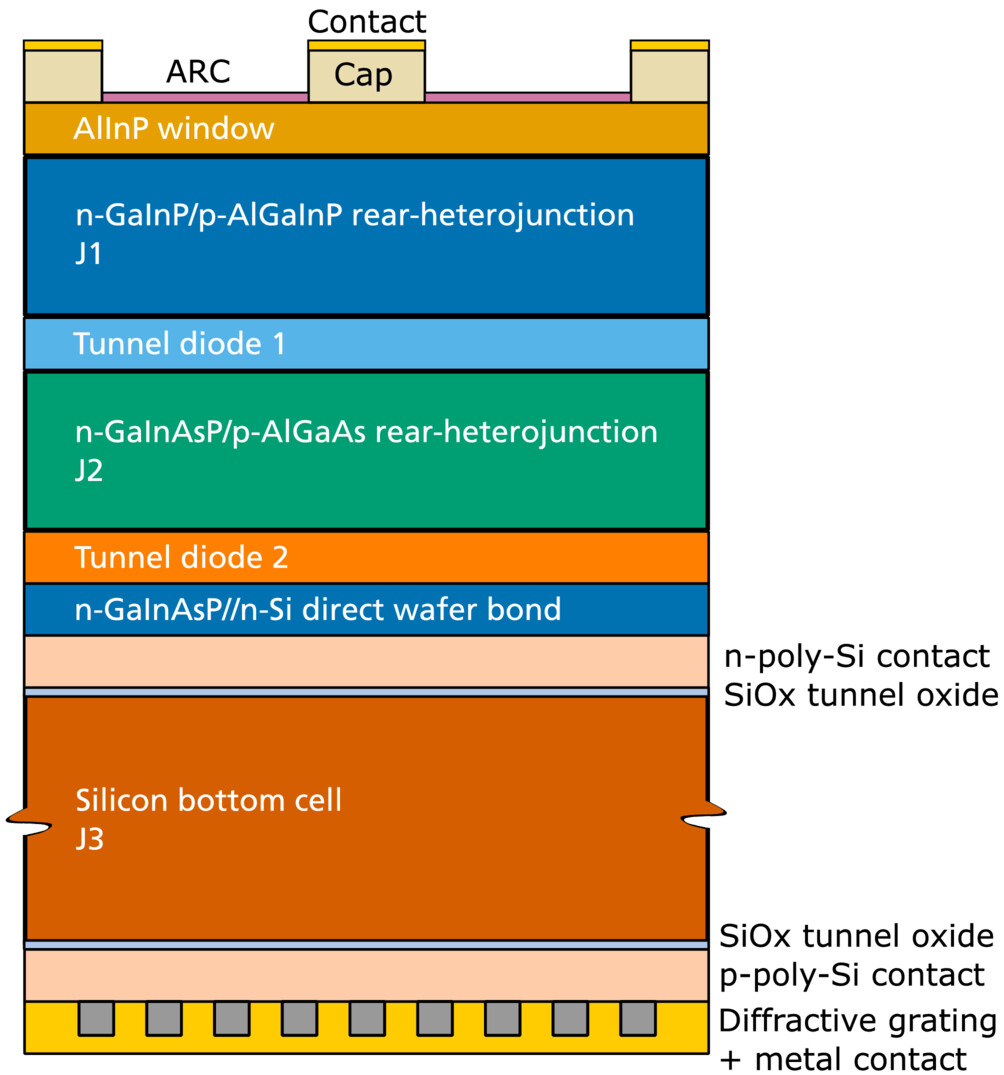Germany's Fraunhofer Institute for Solar Energy Systems (Fraunhofer ISE) and Dutch research institute AMOLF have provided an extensive technical description of the record-breaking silicon-based multijunction solar cell unveiled in late September.
In the paper “Wafer-bonded two-terminal III-V//Si triple-junction solar cell with power conversion efficiency of 36.1% at AM1.5 g,” published in Progress in Photovoltaics, scientists from the two research institutes explained that the main feature of the monolithic cell design consists of wafer-bonding the III-V top cell structure to the silicon bottom cell.
The triple-junction cell utilizes a top cell based on gallium indium phosphide (GaInP), a middle cell relying on gallium indium arsenide phosphide (GaInAsP), and a silicon tunnel oxide passivated contact (TOPCon) bottom cell. “The middle cell was deposited first and the top cell second on the GaAs substrate to reduce the voltage drop in the top cell due to a high thermal load,” the researchers explained. “The upright growth fashion made it necessary to temporarily bond the epitaxial structure to a sapphire wafer as mechanical support.”
The group attached the GaInP/GaInAsP top structure to the TOPCon devices by using surface-activated direct wafer bonding. They then implemented rear-side grating through nanoimprint lithography. The cell utilizes a metallodielectric back-side reflector to enhance light trapping in the bottom cell and a specially designed metal/polymer nanocoating provided by AMOLF.
“By employing a rear-heterojunction cell design in both the middle and top cell, the open-circuit voltage of the triple-junction device could be improved by 61 mV compared to previous generations,” the scientists explained. “Due to the high minority carrier lifetime of the n-absorber material, the external radiative efficiency is higher compared to a reference device with a homojunction cell design.”
Tested under standard illumination conditions, the triple-junction cell achieved a power conversion efficiency of 36.1%, an open-circuit voltage of 3.309 V, a short-circuit density of 12.7 mA/cm2, and a fill factor of 86.0%.
“The main reason for the higher efficiency compared to the last generation of III-V//Si triple-junction solar cells made at Fraunhofer ISE is the increase in open-circuit voltage by 61 mV,” the group explained. “The major difference compared to the previous generation is the inclusion of a rear-heterojunction cell configuration in place of the former homojunction cell design for the middle cell.”
Looking forward, the academics said they want to further reduce optical losses in the device through a four-layer anti-reflection coating. “The electrical losses in the silicon bottom cell due to surface recombination at the unpassivated mesa trenches will be alleviated in the future if this technology is scaled to larger solar cell sizes,” they stated.
This content is protected by copyright and may not be reused. If you want to cooperate with us and would like to reuse some of our content, please contact: editors@pv-magazine.com.




5 comments
By submitting this form you agree to pv magazine using your data for the purposes of publishing your comment.
Your personal data will only be disclosed or otherwise transmitted to third parties for the purposes of spam filtering or if this is necessary for technical maintenance of the website. Any other transfer to third parties will not take place unless this is justified on the basis of applicable data protection regulations or if pv magazine is legally obliged to do so.
You may revoke this consent at any time with effect for the future, in which case your personal data will be deleted immediately. Otherwise, your data will be deleted if pv magazine has processed your request or the purpose of data storage is fulfilled.
Further information on data privacy can be found in our Data Protection Policy.